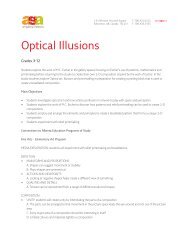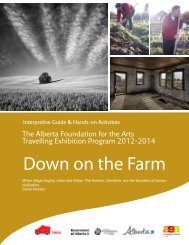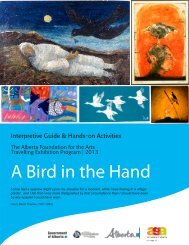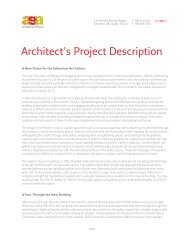Urban Animals - Art Gallery of Alberta
Urban Animals - Art Gallery of Alberta
Urban Animals - Art Gallery of Alberta
You also want an ePaper? Increase the reach of your titles
YUMPU automatically turns print PDFs into web optimized ePapers that Google loves.
The <strong>Alberta</strong> Foundation for the <strong>Art</strong>s Travelling Exhibition Program<br />
Animal Studies: Rabbit<br />
Rabbits are small mammals in the family<br />
Leporidae. There are eight different genera in<br />
the family classified as rabbits, including the<br />
European rabbit, cottontail rabbits, and the<br />
Amami rabbit. There are many other<br />
species <strong>of</strong> rabbit and these, along with pikas<br />
and hares, make up the order Lagomorpha.<br />
Rabbits are found in many parts <strong>of</strong> the<br />
world. Their habitats include meadows,<br />
woods, forests, grasslands, deserts and wetlands.<br />
More than half the world’s rabbit populations<br />
resides in North America. Rabbits live<br />
in groups, and the best known species, the<br />
European rabbit, lives in underground burrows<br />
or rabbit holes. A group <strong>of</strong> burrows is called a<br />
warren.<br />
Jason Carter<br />
The Rabbit, 2012<br />
Acrylic on canvas<br />
Collection <strong>of</strong> the artist<br />
Rabbits are perfectly suited for their environments. The rabbit’s long ears, which can be<br />
more than 4 inches long, are probably an adaptation for detecting predators. They also have<br />
large, powerful hind legs. The two front paws have 5 toes while the hind feet have 4 toes. Their<br />
size can range anywhere from 8 inches in length and .4kg in weight to 20 inches in length and<br />
more than 2 kg. The fur is most commonly long and s<strong>of</strong>t, with colors such as shades <strong>of</strong> brown,<br />
gray, and buff. Rabbits have two sets <strong>of</strong> incisor teeth, one behind the other. This way they can<br />
be distinguished from rodents.<br />
Rabbits are hervibores. They feed by grazing on grass, forbs, and leafy weeds. In<br />
consequence their diet contains large amounts <strong>of</strong> cellulose which is hard to digest. Rabbits<br />
graze heavily and rapidly for roughly the first half hour <strong>of</strong> a grazing period - usually in the late<br />
afternoon - followed by about half an hour <strong>of</strong> more selective feeding. Rabbits are hindgut<br />
digesters. This means that most <strong>of</strong> their digestion takes place in their large intestine and<br />
cecum. This is a secondary chamber between the large and small intestine containing large<br />
quantities <strong>of</strong> symbiotic bacteria that help with the digestion <strong>of</strong> cellulose and also produce certain<br />
B vitamins. The unique musculature <strong>of</strong> the cecum allows the intestinal tract <strong>of</strong> the rabbit to<br />
separate fibrous material from more digestible material: the fibrous material is passed as feces,<br />
while the more nutritious material is encased in a mucous lining as a cecotrope. Cecotropes,<br />
sometimes called ‘night feces’, are high in minerals, vitamins and proteins that are necessary to<br />
the rabbit’s health. Rabbits eat these to meet their nutritional requirements.<br />
Rabbits are prey animals and are constantly aware <strong>of</strong> their surroundings. If confronted by<br />
a potential threat, a rabbit may freeze and observe then warn others in the warren with powerful<br />
thumps on the ground. Rabbits have a remarkably wide field <strong>of</strong> vision, and a good deal <strong>of</strong> it is<br />
devoted to overhead scanning. They survive predation by burrowing, hopping away in a zig-zag<br />
motion and, if captured, delivering powerful kicks with their hind legs or by biting.<br />
AFA Travelling Exhibition Program, Edmonton, AB. Ph: 780.428.3830 Fax: 780.421.0479<br />
youraga.ca

















